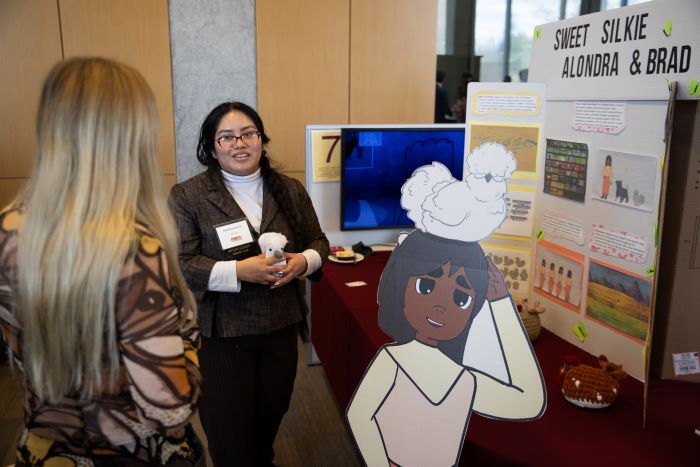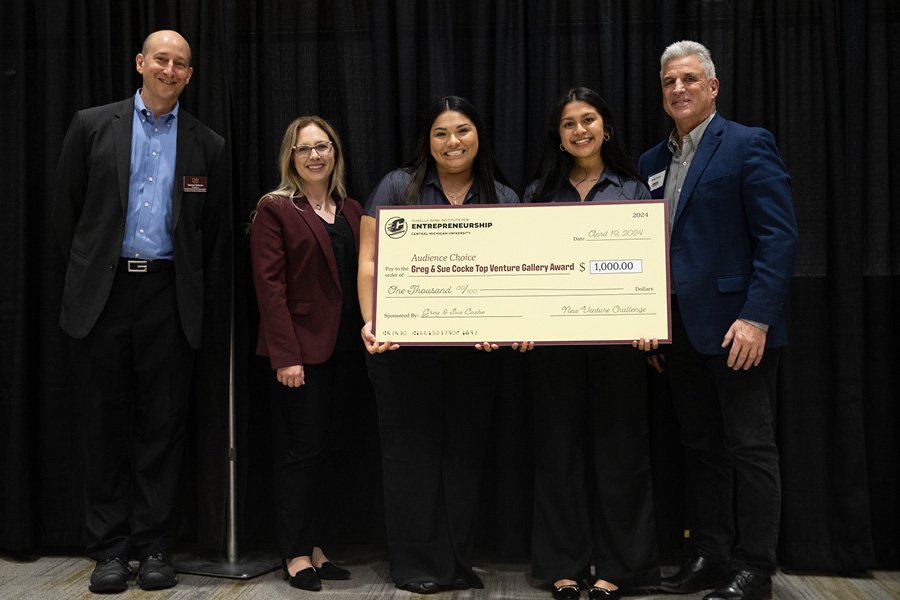
Start up
Passion. Potential. Pitches. Don't miss any of the 2025 New Venture Challenge excitement.
Tune in Friday, April 11 at 1 p.m. for great ideas and fierce competition. Then, join the judges, mentors, spectators and teams as they see who is going home with thousands of dollars in venture financing. The awards broadcast begins at 6:30 p.m. and one team will walk away as the overall best venture.
Central Michigan University’s College of Business Administration is the home of the Isabella Bank Institute for Entrepreneurship and the first Department of Entrepreneurship in the state of Michigan. We are a student-centric hub where experiential, curricular, and external entrepreneurial opportunities intersect.
Our mission is to maximize student success by fostering a campus-wide entrepreneurial mindset that promotes inter-disciplinary collaboration and the creation of new ventures.
We aim to create innovative programming, boost cross-campus and ecosystem collaboration and provide a comprehensive mentoring program.
Our institute provides extracurricular opportunities and is open to all undergraduate and graduate CMU students.
Are you interested in becoming an entrepreneur?
Every journey is unique. Explore the opportunities that interest you.
Extreme heat waves are the deadliest natural disasters. The most serious heat-related illness is heat stroke, which occurs when the body no longer controls its own temperature. In a warming world, extreme heat waves are expected to become more common.
Micah Zuhl is a member of Central Michigan University’s health sciences faculty. He shared his expertise on what heat stroke is and how you can stay safe in extreme heat.

Heat stroke is a complex scenario where the mechanisms that help cool your body during exposure to a hot environment have failed. This leads to an unmitigated increase in body temperature. If left untreated, heat stroke can cause dangerous heart rhythms, tissue injury (kidneys, gut, brain), sepsis and ultimately death. Individuals are susceptible when their core body temperature rises above 104 °F (40°C).
The hypothalamus in the brain is the central controller of body temperature. Information from the skin, and brain and blood, receptors determines if warming or cooling responses should be initiated.
During exposure to a hot environment, blood flow will be directed to the skin to help remove heat. In addition, sweating begins which is the primary cooling mechanism. Importantly, sweat must evaporate for it to be effective at cooling the body.
Humid environments (humidity greater than 72%) are dangerous because evaporative cooling of sweat is compromised. If profuse sweating continues over a prolonged duration, then there is less blood volume available to help with cooling. This leads to a rise in body temperature.
Tissue damage occurs when body temperature rises which triggers a complex interplay of inflammatory events and coagulopathy that mimics sepsis. The gastrointestinal tract is thought to be central component in this cascade as permeability of toxins from the gut can translocate into the blood and invoke inflammatory events.
Workers or exercisers who develop heat stroke often experience skeletal muscle tissue damage (e.g., rhabdomyolysis) that can coincide with further kidney damage and failure. Multiorgan damage combined with inflammatory events in heat stroke victims have been associated with blood clotting abnormalities that range from activation of blood clotting factors to hemorrhage which are often seen in sepsis. The systemic effect of heat stroke makes it difficult to treat.
Central nervous system dysfunction, including loss of coordination, delirium, convulsions, and/or coma can occur during heat stroke. Other common milder symptoms are dizziness, vomiting, extreme headache, and excessive muscle cramping. In a conscious person who is experiencing heat stroke symptoms, the primary treatment is rapid body cooling. This is best achieved by placing an individual in cool water (~50°F) until core temperature decreases to 102°F (38.88°C).
In someone who loses consciousness, the first concern is the ensuring that the individual is protecting their airway, breathing, and has a pulse (circulation). Rapid cooling should then proceed. Accurately monitoring someone’s core temperature during a heat stroke event is imperative to prevent overcooling. Clinicians will often use rectal or esophageal thermometer probes to assess an individual.
 Elderly, children, individuals performing physical working in a hot climate, and those with a history of heat stroke are at heightened risk. Strategies to prevent heat stroke are critical, especially among individuals working in the heat as evidence suggests that heat stroke is four times more likely to occur in workers. Alarming is the prediction that heat stroke will kill a worker every ~20 minutes by 2030.
Elderly, children, individuals performing physical working in a hot climate, and those with a history of heat stroke are at heightened risk. Strategies to prevent heat stroke are critical, especially among individuals working in the heat as evidence suggests that heat stroke is four times more likely to occur in workers. Alarming is the prediction that heat stroke will kill a worker every ~20 minutes by 2030.
The pillars to prevention include hydration, taking consistent rest breaks, acclimation and education. Hydrating before exposure to a hot climate is highly encouraged and drinking roughly 1 cup of fluids every 15-20 minutes has shown to prevent excessive dehydration. Water is generally effective and the addition of electrolyte drinks that contain carbohydrate can also help with hydration.
Maintaining fluid consumption after heat exposure is also important to ensure adequate recovery. Taking consistent rest breaks is another recommend strategy to prevent heat stroke. One example is 45 minutes of work followed by 15 minutes of rest every hour.
Rest breaks become more important as environmental temperature increases. Acclimation is when the body adapts to heat by improving cooling mechanisms and occurs after 8-10 days of consistent heat exposure. Daily workload should be adjusted to allow for the benefits of acclimation to happen.
Lastly, education is key to preventing heat stroke. Individuals chronically exposed to heat should learn the symptoms of milder heat illness such as heat exhaustion which if recognized will prevent the progression to heat stroke. Educating about proper hydration, taking adequate breaks and having a buddy system (checking on a co-worker) are also important strategies.
About Micah Zuhl
Micah Zuhl is a faculty member in the Department of Health Sciences at Central Michigan University. He received his Doctorate in Exercise Physiology from the University of New Mexico in 2012, and his Masters in Exercise Physiology from Western Michigan University in 2007.
His research interests include examining the physiological stress response to exercise in various environmental conditions and developing progressive therapies for people in cardiac rehabilitation, and people with substance abuse disorders and mood disorders.

Explore special opportunities to learn new skills and travel the world.

Present your venture and win BIG at the New Venture Challenge.

Boost your entrepreneurial skills through our workshops, mentor meetups and pitch competitions.

Learn about the entrepreneurship makerspace on campus in Grawn Hall.

Present a 2-minute pitch at the Make-A-Pitch Competition and you could win prizes and bragging rights!

Connect with mentors and faculty who are here to support the next generation of CMU entrepreneurs.

Are you a CMU alum looking to support CMU student entrepreneurs? Learn how you can support or donate to the Entrepreneurship Institute.